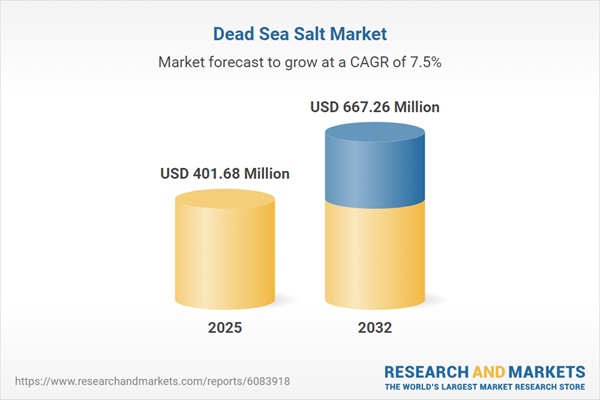Speak directly to the analyst to clarify any post sales queries you may have.
The Dead Sea salt market is experiencing a transformation, fueled by rising consumer demand, innovative applications across sectors, and an evolving regulatory landscape. Senior decision-makers must closely monitor market developments and leverage actionable insights to maintain competitive positioning in this growing global segment.
Market Snapshot: Dead Sea Salt Market Growth and Trends
The Dead Sea salt market grew from USD 374.09 million in 2024 to USD 401.68 million in 2025. Projected to expand further at a 7.50% CAGR, the market is anticipated to reach USD 667.26 million by 2032.
Core growth is driven by increasing awareness of wellness benefits, product innovation, and diversified end-use sectors, amplifying the role of Dead Sea salt in health, beauty, and nutrition.Scope & Segmentation
This report comprehensively analyzes the Dead Sea salt industry across major applications, product varieties, and regional landscapes, incorporating technological innovation, supply chain, and shifting consumer preferences.
- Applications: Bath & Spa, Cosmetics, Food & Beverage, Health & Wellness, Pharmaceutical
- Product Types: Bath Salt (Blended Bath Salt, Dead Sea Bath Salt), Cosmetic Salt (Lotions & Creams, Masks, Scrubs), Industrial Salt, Table Salt
- Distribution Channels: Direct Sales, Online Retail (Brand Websites, Marketplaces), Pharmacies & Drugstores, Specialty Stores (Beauty Stores, Wellness Centers), Supermarkets & Hypermarkets
- End Users: Cosmetics Industry, Food Processing Industry, Hospitality Sector (Health Clubs, Hotels, Spas & Wellness Centers), Household, Pharmaceutical Industry
- Forms: Crystals, Granules, Powder
- Regions: Americas (United States, Canada, Mexico, Brazil, Argentina, Chile, Colombia, Peru), Europe, Middle East & Africa (UK, Germany, France, Russia, Italy, Spain, Netherlands, Sweden, Poland, Switzerland, UAE, Saudi Arabia, Qatar, Turkey, Israel, South Africa, Nigeria, Egypt, Kenya), Asia-Pacific (China, India, Japan, Australia, South Korea, Indonesia, Thailand, Malaysia, Singapore, Taiwan)
- Leading Companies: AHAVA Dead Sea Laboratories Ltd, Premier Dead Sea Cosmetics Ltd, Seacret Direct LLC, Health & Beauty Dead Sea Cosmetics Ltd, Dead Sea Spa Magik LLC, Rogin Dead Sea Innovation Ltd, Salt of the Earth Corporation, Wala Heilmittel GmbH, Haseen Cosmetics LLC, Natural Ways Dead Sea Products Ltd
Key Takeaways for Senior Decision-Makers
- Innovative extraction and mineral preservation technologies elevate the value and purity of Dead Sea salt products, supporting both established and emerging applications.
- Rising consumer demand for traceability, sustainability certifications, and clean-label products influences procurement, branding, and regulatory compliance strategies across all market tiers.
- Expansion into advanced cosmetics, functional foods, and wellness regimes reflects premiumization as well as consumer willingness to invest in products with authentic origin stories.
- Regional dynamics dictate differentiated strategies: North America leverages local manufacturing and tailored formulations, while proximity advantages affect logistics and pricing in the Middle East and Europe.
- Alliances among producers, biotechnology firms, and research institutions foster proprietary product development and enable companies to enter new high-value segments.
- Investment in digital channels—e-commerce and personalized retail solutions—supports both direct-to-consumer growth and B2B partnerships, while underpinning customer engagement and loyalty.
Tariff Impact: Navigating Trade and Supply Chain Adjustments
The latest United States tariff adjustments have altered import duties on mineral products, compelling stakeholders to reconsider sourcing networks, optimize freight routes, and explore regional partnerships. Companies are assessing dynamic pricing strategies and cost absorption models to mitigate supply chain pressures, maintaining operational flexibility against shifting fiscal and regulatory requirements.
Methodology & Data Sources
This Dead Sea salt market report integrates primary research through interviews with supply chain leaders, product formulators, and end users, complemented by thorough secondary analysis of industry publications, regulatory filings, and peer-reviewed studies. Quality assurance processes and multi-stage reviews ensure data integrity and actionable insight for stakeholders.
Why This Report Matters
- Enables senior executives to identify high-value growth areas and anticipate shifts in technology, sourcing, or consumer demand across the Dead Sea salt market.
- Supports data-driven decision-making with in-depth analysis of regulatory trends, supply chain vulnerabilities, and competitive moves among industry leaders.
- Equips stakeholders with region-specific strategies for product development, distribution optimization, and sustainability initiatives that align with evolving market standards.
Conclusion
As the Dead Sea salt industry grows in complexity and opportunity, decision-makers are equipped to align innovation, operational agility, and strategic expansion for long-term success. This report delivers a reliable foundation for capitalizing on sector trends and achieving resilient market growth.
Table of Contents
3. Executive Summary
4. Market Overview
7. Cumulative Impact of Artificial Intelligence 2025
Companies Mentioned
The companies profiled in this Dead Sea Salt market report include:- AHAVA Dead Sea Laboratories Ltd
- Premier Dead Sea Cosmetics Ltd
- Seacret Direct LLC
- Health & Beauty Dead Sea Cosmetics Ltd
- Dead Sea Spa Magik LLC
- Rogin Dead Sea Innovation Ltd
- Salt of the Earth Corporation
- Wala Heilmittel GmbH
- Haseen Cosmetics LLC
- Natural Ways Dead Sea Products Ltd
Table Information
| Report Attribute | Details |
|---|---|
| No. of Pages | 181 |
| Published | November 2025 |
| Forecast Period | 2025 - 2032 |
| Estimated Market Value ( USD | $ 401.68 Million |
| Forecasted Market Value ( USD | $ 667.26 Million |
| Compound Annual Growth Rate | 7.5% |
| Regions Covered | Global |
| No. of Companies Mentioned | 11 |









